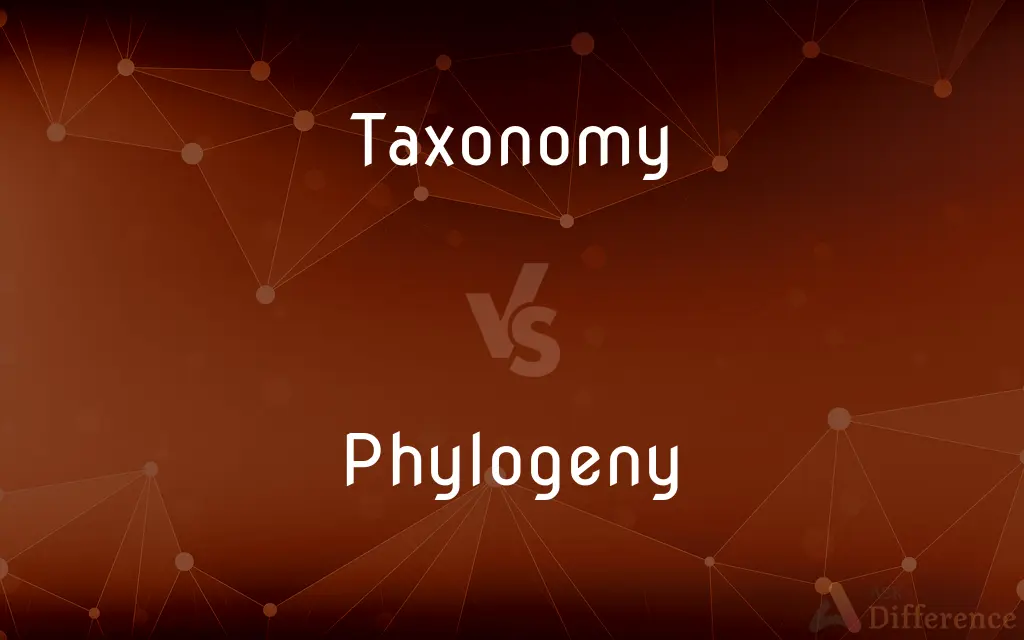Taxonomy vs. Phylogeny — What's the Difference?
By Urooj Arif & Fiza Rafique — Updated on March 21, 2024
Taxonomy involves the classification of organisms based on shared characteristics, while phylogeny represents the evolutionary relationships among species.

Difference Between Taxonomy and Phylogeny
Table of Contents
ADVERTISEMENT
Key Differences
Taxonomy is a hierarchical system of classification that organizes living organisms into groups such as domain, kingdom, phylum, class, order, family, genus, and species, based on physical and genetic similarities. Phylogeny, on the other hand, is concerned with the evolutionary history and relationships among organisms, often depicted as a phylogenetic tree showing ancestral lineages and points of divergence.
The primary goal of taxonomy is to name, describe, and classify organisms into a structured system that can be universally understood, facilitating identification and study. Whereas phylogeny aims to understand the evolutionary pathways that have led to the diversity of life on Earth, focusing on how species are related through common ancestry.
Taxonomic classification relies heavily on observable characteristics, both morphological and genetic, to group organisms. Phylogenetic analyses, however, use data from various sources, including molecular (DNA, RNA, proteins) and morphological evidence, to infer evolutionary relationships, emphasizing the sequence in which different groups of organisms have branched off from common ancestors.
Taxonomy has undergone significant changes with the advent of molecular techniques, leading to reclassification of many species based on genetic information. Phylogeny also evolves with new data, constantly refining our understanding of evolutionary relationships as more genetic information becomes available.
While taxonomy provides a convenient framework for organizing the vast diversity of life and facilitates communication among biologists, phylogeny offers insights into the evolutionary processes that generate this diversity, highlighting the connections and divergences among species over time.
ADVERTISEMENT
Comparison Chart
Definition
The science of classifying organisms based on shared characteristics.
The study of the evolutionary history and relationships among organisms.
Focus
Classification and nomenclature.
Evolutionary relationships and lineage.
Methods
Uses morphological, genetic, and biochemical characteristics.
Relies on morphological and molecular data to infer evolutionary pathways.
Outcome
Hierarchical system (e.g., kingdom, phylum, class).
Phylogenetic trees showing evolutionary relationships.
Application
Facilitates identification, study, and communication about organisms.
Provides insights into evolutionary processes and species divergence.
Compare with Definitions
Taxonomy
The science of classifying and naming organisms based on shared characteristics.
In taxonomy, lions are classified as Panthera leo, where Panthera is the genus and leo is the species.
Phylogeny
The study of the evolutionary history and relationships among organisms or groups of organisms.
The phylogeny of birds suggests they evolved from theropod dinosaurs.
Taxonomy
Subject to revision based on new findings but aims for stability in naming and classification.
The reclassification of the giant panda from the raccoon family to the bear family was based on new genetic evidence.
Phylogeny
Often depicted as phylogenetic trees, showing paths of descent and divergence.
A phylogenetic tree of mammals highlights the divergence from reptilian ancestors.
Taxonomy
Organizes life into a structured hierarchy from kingdom to species.
Humans are classified as Animalia (kingdom), Chordata (phylum), Mammalia (class), Primates (order), Hominidae (family), Homo (genus), and sapiens (species).
Phylogeny
Provides insights into how species have evolved and diversified over time.
Phylogenetic studies show that cetaceans (whales and dolphins) share a closer ancestor with hippopotamuses than with other marine animals.
Taxonomy
Uses binomial nomenclature for a standardized naming system.
The domestic dog is formally known as Canis lupus familiaris.
Phylogeny
Reflects the ongoing discovery and reevaluation of evolutionary relationships.
The discovery of new fossils can lead to revisions in the phylogenetic tree of human ancestors.
Taxonomy
Based on physical, genetic, and behavioral characteristics.
Birds are classified into the class Aves based on features like feathers, beaks, and egg-laying.
Phylogeny
Utilizes genetic, morphological, and sometimes fossil data to infer evolutionary relationships.
DNA sequencing has greatly enhanced our understanding of phylogenetic relationships among species.
Taxonomy
The classification and naming of organisms in an ordered system that is intended to indicate natural relationships, especially evolutionary relationships.
Phylogeny
The evolutionary development and history of a species or trait of a species or of a higher taxonomic grouping of organisms
The phylogeny of Calvin cycle enzymes. Also called phylogenesis.
Taxonomy
The science, laws, or principles of classification.
Phylogeny
A model or diagram delineating such an evolutionary history
A molecular phylogeny of the annelids.
Taxonomy
An ordered arrangement of groups or categories
A taxonomy of literary genres.
Phylogeny
A similar model or diagram delineating the development of a cultural feature.
Taxonomy
The science or the technique used to make a classification.
Phylogeny
(systematics) The evolutionary history of groups of organisms, such as species or clades.
Taxonomy
A classification; especially, a classification in a hierarchical system.
Phylogeny
A phylogenetic diagram.
Taxonomy
The science of finding, describing, classifying and naming organisms.
Phylogeny
The historical development of a human social or racial group.
Understanding the phylogeny of this musical group helps us understand its music.
Taxonomy
That division of the natural sciences which treats of the classification of animals and plants, primarily by consideration of their natural relationships with respect to their structure or genetic origin; the laws or principles of classification; systematics.
Phylogeny
The historical development of any thing, idea, etc.
Taxonomy
A systematic arrangement of objects or concepts showing the relations between them, especially one including a hierarchical arrangement of types in which categories of objects are classified as subtypes of more abstract categories, starting from one or a small number of top categories, and descending to more specific types through an arbitrary number of levels. An ontology usually contains a taxonomy as one of the important principles of organization.
Phylogeny
(biology) the sequence of events involved in the evolutionary development of a species or taxonomic group of organisms
Taxonomy
A classification of organisms into groups based on similarities of structure or origin etc
Taxonomy
(biology) study of the general principles of scientific classification
Taxonomy
Practice of classifying plants and animals according to their presumed natural relationships
Common Curiosities
What is the main goal of taxonomy?
The main goal of taxonomy is to classify and name organisms in a systematic way, providing a universal framework for identification.
How does phylogeny contribute to our understanding of evolution?
Phylogeny reveals the evolutionary relationships and history among species, helping us understand how species have evolved and diverged over time.
Can the taxonomic classification of an organism change due to new phylogenetic evidence?
Yes, taxonomic classifications can be revised based on new phylogenetic insights, reflecting more accurate evolutionary relationships.
How do taxonomy and phylogeny interact with each other?
Taxonomy and phylogeny are interconnected; taxonomic classifications often incorporate phylogenetic information to reflect evolutionary relationships.
What role do fossils play in understanding phylogeny?
Fossils provide critical evidence of ancestral forms and traits, helping to fill gaps in our understanding of evolutionary lineages.
What challenges do scientists face in constructing phylogenetic trees?
Challenges include limited or conflicting data, interpreting genetic differences, and integrating diverse sources of information to infer accurate evolutionary paths.
What is the significance of a phylogenetic tree?
A phylogenetic tree visualizes the evolutionary relationships among species, showing how they have diverged from common ancestors.
Why is binomial nomenclature important in taxonomy?
Binomial nomenclature provides a standardized, universally accepted naming system that facilitates clear communication and identification across the scientific community.
How has molecular biology impacted phylogeny?
Molecular biology, especially DNA sequencing, has revolutionized phylogeny by providing precise genetic data, leading to more accurate reconstructions of evolutionary histories.
Can an organism belong to more than one taxonomic group?
Organisms are assigned to specific groups at each taxonomic level, but they can belong to multiple levels of the hierarchy, such as being part of a species, genus, family, etc.
Share Your Discovery

Previous Comparison
Hamets vs. Chametz
Next Comparison
Donut vs. BagelAuthor Spotlight
Written by
Urooj ArifUrooj is a skilled content writer at Ask Difference, known for her exceptional ability to simplify complex topics into engaging and informative content. With a passion for research and a flair for clear, concise writing, she consistently delivers articles that resonate with our diverse audience.
Co-written by
Fiza RafiqueFiza Rafique is a skilled content writer at AskDifference.com, where she meticulously refines and enhances written pieces. Drawing from her vast editorial expertise, Fiza ensures clarity, accuracy, and precision in every article. Passionate about language, she continually seeks to elevate the quality of content for readers worldwide.















































